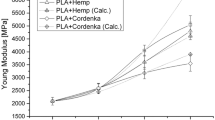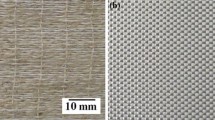Abstract
Natural and wood fibre reinforced plastics as a relatively new group of environmental friendly materials have been extensively applied in interior, building applications and in the automobile industry. Among others, natural and wood fibre reinforced foamed polymer materials are of high significance because of the possibility of their reducing the density of automotive components which have a cellular structure. However, the properties of these materials have not been fully investigated and described. Microcellular composites of polypropylene containing natural and wood fibre was prepared using an injection moulding process. In the present work, the manufacturing technology of natural and wood fibre reinforced polymer microfoams was developed and the influence of fibre and microvoid content on its property spectrum was systematically investigated. The forming of microvoids and the degree of foaming related to the variation of the processing parameters in connection with manufacture technology was characterised. Measurement of density, cell size, tensile and flexural properties of the prepared composites was carried out. The cell structure is dependent on flow direction of foaming. The density of microfoamed wood fibre-PP composites was reduced by about 24% and decreased by as much as 0.77 g/cm3.Light microscopy showed that the cells are circular and it was also observed that the maximum cell sizes are between 10–50 μm. Water absorption and scanning electron microscopy of the composites were also investigated. Considering the experimental results, it can be deduced that the microcellular composites exhibit a possible combination of relatively good engineering properties and lower density for different technical applications.
Zusammenfassung
Natur- und holzfaserverstärkte Kunststoffe, als relativ neue Gruppe von umweltfreundlichen Werkstoffen, werden derzeit in beachtlichem Umfang in der Bauindustrie (Dach-, Boden- und Wändeabdeckungen) und Automobilindustrie verwendet. Ausserdem haben natur- und holzfaserverstärkte Polymerwerkstoffe –Mikroschäume, die wegen ihrer zellularen Struktur die Dichte der Bauteile noch reduzieren können, eine immer größere Bedeutung erlangt. Bisher sind die Eigenschaften dieser Werkstoffe nur beschränkt untersucht und beschrieben worden. Natur- und holzfaserverstärkte PP-Mikroschäume wurden im Spritzgießverfahren hergestellt. Im Rahmen der vorliegenden Arbeit wurde die Fertigungstechnik der natur- und holzfaserverstärkten Polymere-Mikroschäume entwickelt und systematisch der Einfluss des Faser-/ und Mikroporengehalts auf das Eigenschaftsspektrum dieser Werkstoffe untersucht. Mikroporen und Schäumungsgrad in Abhängigkeit von der Variation der Verarbeitungsparameter wurden in Verbindung mit dem Herstellungsprozess charakterisiert. Die Dichte, die Zellgröße, die Zug- und Biegeparameter der hergestellten Compositen wurden ermittelt. Die Schaumstruktur ist vom Fließweg abhängig. Die Dichte von geschäumten holzfaserverstärkten PP kann bis ca. 24% reduziert werden und erreicht Werte von 0,77 g/cm3. Die mikroskopischen Aufnahmen zeigen, dass die Mikroporen eine runde Struktur aufweisen, und der Porendurchmesser zwichen 10–50 μm liegt. Die Wasseraufnahme wurde ebenfalls untersucht. Die erzielten Ergebnisse belegen, dass diese Werkstoffe für verschidene Anwendungen in der Technik geeignet sind.













Similar content being viewed by others
References
Baer E (1964) Engineering Design for Plastics, SPE Polymer Science and Engineering Series. Reinhold, New York
Barth C (2000) Stopp dem Riss, Hohlräume steigern die Schlagzähigkeit von PC. Kunststoffe 90(12):97–99
Bernhardt EC (1959) Processing of Thermoplastics Materials SPE Plastics Engineering Series. Reinhold, New York
Bledzki AK, Zhang W (2001) Dynamic mechanical properties of natural fiber-reinforced epoxy foams. J Reinforced Plastics and Composites 20:1263–1274
Bledzki AK, Gassan J, Theis S (1998) Wood-filled thermoplastic composites. Mechanics of Composites Materials 34(6):795–802
Bledzki AK, Zhang W, Chate A (2001) Natural fibre-reinforced polyurethane microfoams. Composites Science and Technology 61:2405–2411
Bledzki AK, Faruk O, Huque M (2002) Physico-mechanical studies of wood fiber reinforced composites. Polym -Plast Technol Eng 41(3):435–451
Domininghaus H (1988) Die Kunststoffe und ihre Eigenschaften. VDI Verlag, Düsseldorf
Ischebeck HU (1984) Qualitätsbeurteilung und Schdensaufklärung an Kunststoff Fertigteilen mit Hilfe der Auflichtmikroskopie. Kunststoffe 74:153–157
Matuana LM, Mengeloglu F (2001a) Microcellular foaming of impact-modified rigid PVC/wood-flour composites. J Vinyl Addit Technol 7(2):67–75
Matuana LM, Mengeloglu F (2001b) Studies on the foamability of rigid PVC/wood-flour composites. SPE ANTEC Tech Papers 3:2997–3002
Matuana LM, Mengeloglu F (2001c) Foaming of rigid PVC/wood-flour composites through a continuous extrusion process. J Vinyl Addit Technol 7(3):142–148
Matuana LM, Park CB, Balatinecz JJ (1996) Characterization of microcellular foamed PVC/cellulosic-fibre composites. J Cellular Plast 32(5):449–469
Matuana LM, Park CB, Balatinecz JJ (1997) Processing and cell morphology relationships for microcellular foamed PVC/wood-fiber composites. Poly Eng Sci 37:1137
Matuana LM, Park CB, Balatinecz JJ (1998) Cell morphology and property relationships of microcellular foamed PVC/wood fibre composites. Poly Eng Sci 38(11):1862–1872
Matuana LM, Balatinecz JJ,Park CB (1999) Foaming of woodfiber-plastic composites. The Fifth International Conference on Wood fiber-Plastic Composites, Poster, Wisconsin, USA, p 318
Mieck KP (1999) Stand und Entwicklung des Einsatzes von Naturfasern und umweltfreundlich hergestellten Cellulosefasern für Composites-eine werkstoffliche Betrachtung. In: Proceedings of 2nd International Symposium “ Werkstoffe aus nachwachsenden Rohstoffen”, Erfurt, Germany
Park CB, Rizvi GM, Zhang H (1999) Fine-celled foaming of woodfiber-plastic composites. The Fifth International Conference on Wood fiber-Plastic Composites, Wisconsin, USA, pp 105–120
Sperber VE (2002) Recent developments in the field of wood and natural fibre composites. In: Proceedings of 4th International Wood and Natural Fibre Composites Symposium, Kassel, Germany, 3(1–8)
Tadmor Z (1974) Molecular orientation in injection molding. Journal of Applied Polymer Science 18:1753–1772
Thorne JL (1996) Thermoplastic Foams, Sherwood Technologies, Inc. Sherwood Publishers, Ohio
Uejo H, Hoshino S (1970) Structure of biaxially oriented polypropylene film. Journal of Applied Polymer Science 14:317–328
Wiegand H, Vetter H (1966) Molekulare Orientierung in Spritzgussteilen als Folge der Verarbeitung Teil 1. Kunststoffe 56:761–769
Wiegand H, Vetter H (1967) Molekulare Orientierung in Spritzgussteilen als Folge der Verarbeitung. Kunststoffe 57:276–284
Zhang (2001) Naturfaserverstärkte polymere Mikroschäume-Herstellung, Struktur, Eigenscgaften. PhD Thesis, University of Kassel, Germany
Zhang H, Rizvi GM, Lin WS, Guo G, Park CB (2001) Development of an extrusion system for fine-celled foaming of wood-fiber composites using a physical blowing agent. SPE ANTEC Tech Papers 2:1746–1758
Author information
Authors and Affiliations
Corresponding author
Rights and permissions
About this article
Cite this article
Bledzki, A.K., Zhang, W. & Faruk, O. Microfoaming of flax and wood fibre reinforced polypropylene composites. Holz Roh Werkst 63, 30–37 (2005). https://doi.org/10.1007/s00107-004-0545-3
Published:
Issue Date:
DOI: https://doi.org/10.1007/s00107-004-0545-3




